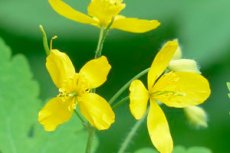Medical expert of the article
New publications
Preparations
Celery for cough in bronchitis
Last reviewed: 04.07.2025

All iLive content is medically reviewed or fact checked to ensure as much factual accuracy as possible.
We have strict sourcing guidelines and only link to reputable media sites, academic research institutions and, whenever possible, medically peer reviewed studies. Note that the numbers in parentheses ([1], [2], etc.) are clickable links to these studies.
If you feel that any of our content is inaccurate, out-of-date, or otherwise questionable, please select it and press Ctrl + Enter.

Celandine is a popular plant in Ukraine, which can be found under almost every house or estate, in parks, squares and even on the roadsides. This unpretentious plant is known to many as a healer of broken knees, because it has a strong antimicrobial, anti-inflammatory and wound-healing effect due to phytoncides, which are called natural antibiotics.
Pharmacodynamics
Few people know that celandine-based compositions can be taken internally, rightly considering the plant to be poisonous. Yes, celandine does indeed contain 5 alkaloids that are dangerous in excessive doses, but largely due to them, the plant has an analgesic and antitumor effect (inhibits tumor growth and prevents metastases).
Celandine also has an expectorant effect, which only a few people know about, although such treatment of cough and bronchitis can be considered more than affordable. Celandine is also used in pneumonia, but you should always remember to strictly adhere to dosages and limit the course of treatment to avoid intoxication of the body.
Dosing and administration
Since celandine is highly poisonous, it should be used only in severe cases of bronchitis or pneumonia. A decoction or infusion of celandine is suitable for treating a severe cough. It is prepared from 1 glass of boiling water and 1 level tablespoon of chopped dry grass. Boil the mixture for 5-7 minutes (keep the infusion warm for about an hour), strain and drink in small quantities in 3-4 doses, enhancing the effect with inhalation procedures.
Contraindications
Due to its high toxicity, celandine has many restrictions on its use. It is clear that such a medicine is not suitable for treating children and pregnant women. It is also prohibited to take it during breastfeeding to avoid toxic effects on the fragile body of the child.
Celandine is contraindicated in the following health conditions:
- epilepsy (high risk of developing a seizure),
- mental disorders, emotional lability, insomnia (celandine causes anxiety, convulsions, clouding of consciousness),
- serious cardiovascular pathologies: angina pectoris, severe heart failure, hypotension (may affect heartbeat due to CNS depression, reduces blood pressure),
- neurological disorders (depresses the activity of the central nervous system, reduces the conductivity of nerve impulses),
- intestinal dysfunction (due to the possibility of developing dysbacteriosis and constipation, as with treatment with synthetic antibiotics),
- inflammatory and ulcerative lesions of the gastrointestinal tract in the acute stage (has an irritating effect on the mucous membrane of the digestive system).
There are also doubts about the benefits of celandine for bronchial asthma, if the plant is capable of causing spasmodic attacks (convulsions).
 [ 9 ]
[ 9 ]
Side effects celandine
Celandine can be considered relatively safe for short-term treatment with low doses of medications based on it. But even in this case, there is a risk of irritation and inflammation of the inner lining of the stomach and intestines, fluctuations in blood pressure (usually a drop in readings), a decrease in heart rate, the appearance of nausea, convulsions, drowsiness, and depressive states. Allergic reactions after taking a decoction or infusion of celandine or during inhalations are considered quite rare.
The situation is even worse if you take celandine-based compositions in large doses or carry out treatment with the herb for a long time. This is fraught with the appearance of overdose symptoms: nausea and vomiting, extreme thirst, diarrhea, a feeling of heaviness in the head and stomach, dizziness. If such symptoms appear, you need to wash out the stomach and stop taking celandine in any form. But people who have hallucinations, confusion or loss of consciousness may even need medical help.
 [ 10 ]
[ 10 ]
Storage conditions
This plant is also harvested during the flowering period, which lasts from May to August. The most useful are those bushes that are hidden in shady places, and not in the sun. It is not recommended to pull out the plant by the roots, it is better to put on gloves and cut the branches at a distance of 8-10 cm above the ground. At the same time, it is not recommended to bend over the plant too much to avoid irritation of the nasal mucosa.
You can dry celandine stems on a prepared surface in a shady place or under a canopy, avoiding exposure to sunlight. In this case, you need to stir the drying raw material as often as possible so that drying is more effective. If you dry celandine for a long time, it will lose some of its beneficial properties.
The optimal way to dry the plant is to hang it in small bunches in a ventilated place. It is also stored in a suspended state, wrapped in a loose cloth or paper and leaving an open space on top for air access. The shelf life of the raw material is 3 years.
Attention!
To simplify the perception of information, this instruction for use of the drug "Celery for cough in bronchitis" translated and presented in a special form on the basis of the official instructions for medical use of the drug. Before use read the annotation that came directly to medicines.
Description provided for informational purposes and is not a guide to self-healing. The need for this drug, the purpose of the treatment regimen, methods and dose of the drug is determined solely by the attending physician. Self-medication is dangerous for your health.

